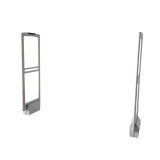Are you looking for ways to revolutionize your B2B logistics operations and streamline your supply chain? Look no further than the RFID gate! This cutting-edge technology has the potential to transform the way you manage your inventory, improve efficiency, and enhance overall visibility in the warehouse. This article will explore the benefits of implementing an RFID gate in your B2B logistics operations.
What is an RFID gate?

An RFID gate, also known as an RFID portal, is an electronic system that uses radio frequency identification technology to track and monitor goods moving through a specific area, such as a warehouse entrance or exit. It consists of RFID readers and antennas strategically placed to capture and transmit data from RFID tags attached to the inventory items. The gate can detect and record the presence of multiple items simultaneously, making it ideal for high-volume operations.
Streamlining B2B Logistics with RFID gates
Implementing RFID gates in your B2B logistics can bring many benefits that can revolutionize your operations. Let’s take a closer look at how RFID gates can transform your supply chain:
Improved inventory management
RFID gates allow you to achieve real-time inventory visibility, allowing for accurate, up-to-date tracking. As goods pass through the gate, the RFID tags are read automatically, updating the inventory database instantly. This enables you to monitor stock levels, identify discrepancies, and optimize replenishment processes, reducing the risk of stockouts and overstocking.
Enhanced efficiency and productivity
Gone are the days of manual scanning and counting inventory. RFID gates automate the data capture process, eliminating the need for manual intervention. This not only saves time but also reduces the chances of human error. Warehouse staff can focus on more value-added tasks, improving productivity and efficiency.
Faster and more accurate order fulfillment
RFID gates enable real-time inventory updates, allowing you to identify item locations and availability quickly. This streamlines the order fulfillment process, ensuring accurate and timely shipments to your B2B customers. With improved inventory accuracy, you can reduce order processing time, minimize order errors, and enhance customer satisfaction.
Efficient tracking and traceability
RFID tags contain unique identification numbers that can be linked to specific products, batches, or shipments. You can establish a comprehensive tracking and traceability system by capturing and storing this data at each RFID gate. This helps identify the origin, movement, and destination of goods, making it easier to address quality issues, recalls, or compliance requirements.
Preventing theft and loss
RFID gates act as a powerful deterrent against theft and loss of inventory. RFID tags on products can discourage theft, as it becomes much more challenging to remove and replace them unnoticed. In case of unauthorized movement, the gate can trigger an alarm, alerting security personnel and allowing immediate intervention.
Cost savings and return on investment
While implementing these gates requires an initial investment, the long-term cost savings and return on investment (ROI) are significant. The increased efficiency, reduced errors, improved inventory management, and theft prevention contribute to cost savings in your B2B logistics operations. Not only will you save money, but you will also see improvements in customer satisfaction and overall business performance.
Where to use an RFID gate

RFID gates offer a wide range of possibilities for implementation across various industries and business operations. Let’s explore where these innovative gates can enhance operational efficiency.
1. Supply Chain Management
- Warehouse management: RFID gates can be installed at warehouse entrances and exits to automatically track inventory movements, reducing the need for manual counting and providing real-time visibility of stock levels.
- Distribution centers: These gates can optimize the flow of goods in distribution centers, streamlining processes such as receiving, sorting, and shipping by automating data capture and minimizing human error.
- Retail stores: Implementing RFID gates at entrances and exits allows for seamless inventory management. This enables retailers to accurately track products from the backroom to the sales floor and improve stock replenishment processes.
2. Access control and security
- Office buildings: RFID gates can be used for employee access control, allowing for swift and secure entry into the premises. These gates can also enhance security by detecting unauthorized item movements and triggering alarms or notifications.
- Stadiums and event venues: RFID gates enable efficient access control for large crowds, enhancing security measures and expediting entry processes during events.
- Healthcare facilities: Implementing RFID gates in hospitals and clinics can improve patient and staff safety by automating access control and monitoring the movement of sensitive inventory, such as medications and medical equipment.
3. Employee attendance and time tracking
- Corporate offices: RFID gates can streamline employee check-in and check-out processes, eliminating the need for manual time-tracking systems and ensuring accurate attendance records.
- Manufacturing facilities: By installing RFID gates at employee entrances and exits, manufacturing companies can automate time tracking, leading to accurate payroll calculations and increased productivity.
4. Asset tracking and management
- Libraries: RFID gates can enhance library operations by automating the check-in and check-out process of books and other materials, improving inventory management, and reducing the risk of lost or misplaced items.
- Museums and galleries: Installing RFID gates at entrance and exit points in museums and galleries allows for automated tracking of artwork and artifacts, ensuring their security and accurate inventory management.
- Logistics and transportation: RFID gates can be employed for efficient tracking of assets such as pallets, containers, and vehicles, minimizing delays and improving supply chain visibility.
By implementing RFID gates in these settings, businesses and organizations can experience enhanced operational efficiency, improved security measures, streamlined workflow processes, and cost savings. The versatility of RFID gates makes them a valuable investment for businesses across different industries. So, why not unlock the potential of RFID gates and take your operational efficiency to new heights?
Conclusion
In conclusion, RFID gates have the potential to transform B2B logistics operations by providing improved inventory management, enhanced efficiency, seamless integration, theft prevention, increased accuracy, and cost savings. By leveraging this innovative technology, you can revolutionize your supply chain and stay ahead of the competition. So, consider implementing RFID gates in your B2B logistics and experience the benefits firsthand.
FAQs
1. What is an RFID gate system?
An RFID gate system is a security and access control solution that utilizes radio frequency identification (RFID) technology to manage the entry and exit of individuals or objects through a physical gate or barrier. The system typically consists of RFID readers installed on the gate, and individuals or items are equipped with RFID tags or cards containing unique identifiers. When a person or object approaches the gate, the RFID reader communicates with the RFID tag or card, authenticating the identity and determining whether access should be granted or denied.
2. Which is better, RFID or NFC?
The choice between RFID and NFC depends on specific needs. RFID suits logistics and inventory management with a longer read range and faster data transfer. NFC, known for short-range communication, excels in contactless payments and data sharing between devices. While RFID offers versatility, NFC’s standardized protocol ensures compatibility in applications requiring proximity and standardized communication.
3. Is RFID more expensive?
RFID technology costs can vary, with factors like frequency and application needs influencing expenses. While RFID may have higher upfront costs than alternatives like barcodes, its advantages, such as faster data capture and improved efficiency in applications like inventory management, often lead to long-term cost savings. The decision on RFID’s cost-effectiveness depends on the specific use case and the overall benefits it brings.
4. Are RFID safe?
RFID technology is generally safe with proper implementation, employing encryption and authentication measures. While not immune to vulnerabilities, periodic updates and monitoring ensure security. RFID is a safe and efficient technology for applications like access control and inventory management when implemented with robust practices.


































